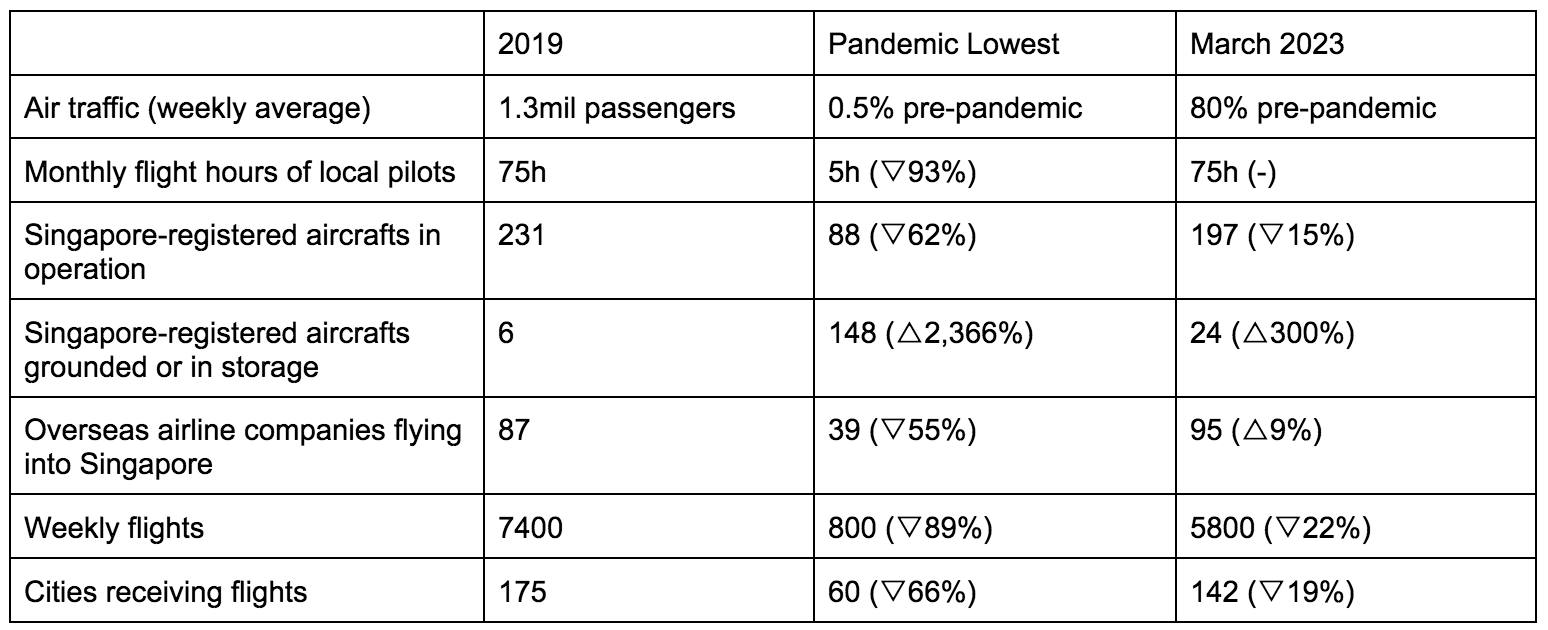The COVID-19 pandemic impacted almost everything in the modern world, but travel was one of the worst-hit aspects by far.
Things seem to be slowly recovering, though—March saw 5,800 weekly flights pass through Changi Airport, around six times higher than the pandemic’s record low.
At this rate, air traffic is projected to return to pre-pandemic levels as soon as next year.
Situation Of The Aviation Industry
To start this off, here’s a table comparing statistics pre-pandemic, post-pandemic, and the pandemic’s record-lows:
It’s worth noting that the six grounded aircraft in 2019 were due to the halt of Boeing 737 MAX flights.
According to these figures provided by the Civil Aviation Authority of Singapore, the monthly flight time of pilots in the local airline industry (Singapore Airlines, Jetstar, Scoot, Jetstar Asia) has already returned to pre-pandemic levels, increasing to 75 hours a week from the record low of five hours.
The number of overseas airline companies flying into Singapore even saw a 9% increase, from 87 to 95.
Air traffic has returned to approximately 80% of pre-pandemic levels as well.
Minister’s Remarks
At the Asia Pacific Summit for Aviation Safety (AP-SAS) held on 22 March, Minister of Transport S. Iswaran spoke about the impact of COVID-19 on air transport in the region.
He expressed that weekly passenger traffic at Changi Airport has recovered to around 80% of pre-COVID levels, and is set to recover fully by next year or even sooner.
He added that air travel in the Asia Pacific has been progressively recovering, and said he was “thankful to have turned the corner”.
Additionally, the International Air Transport Association predicts that the Asia Pacific region will boast the fastest growth in air travel— passenger traffic is anticipated to double in the next 20 years.
In light of this, Mr Iswaran stressed that it was essential to “cast our eyes further ahead” as the industry recovers from the pandemic.
He also stated that a top priority for the industry was safety amid increasing air traffic levels.
“I believe three key elements will set a strong foundation for aviation safety in the region and beyond: building resilience, growing capabilities, and fostering collaboration,” he said at the conference.
Advertisements
To achieve this, Singapore published its first National Aviation Safety Plan last year, which sets safety priorities and details action steps needed to ensure safety.
Mr Iswaran also announced the establishment of the Asia Pacific Centre for Aviation Safety (AP-CAS), which will “serve as a hub for thought leadership in aviation safety”.
Since aviation quite literally transcends borders, the regional hub will promote cross-border collaboration in increasing safety awareness throughout the industry.
The Aviation Summit
The three-day long AP-SAS was jointly organised by the Civil Aviation Administration of China and the Flight Safety Foundation. More than 400 government officials and industry leaders from 35 countries attended.
Vice President of the IATA’s Asia Pacific region Wu Shimian discussed air traffic in a panel discussion on the first day. According to him, total air passenger traffic in the region recovered to around 70% of 2019 levels as of January, a 115% increase from the same period last year.
Advertisements
This growth rate is set to increase as China opens its borders.
Read Also:
- 17YO Who Died in Tampines Accident Was a Promising Student; Dad Works in Police Coast Guard
- Trailer of Deadpool & Wolverine Dropped; Movie to be Released on 25 July
- 80 Earthquakes Hit Taiwan All Night, Swaying Buildings; No Casualties Reported Yet
- Names & Email Addresses of Parents & Staff from 127 MOE Schools Leaked After App Managing Students’ Devices Hacked
- 8 Highlights That Happened During Star Awards 2024 That You Might’ve Missed
Advertisements


